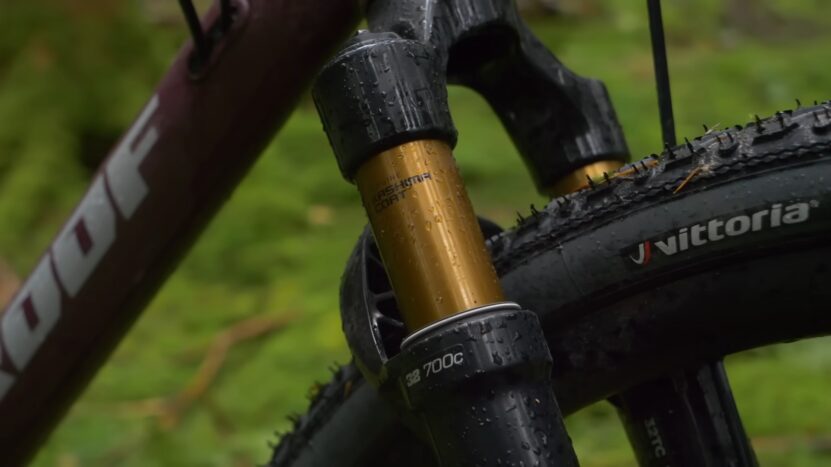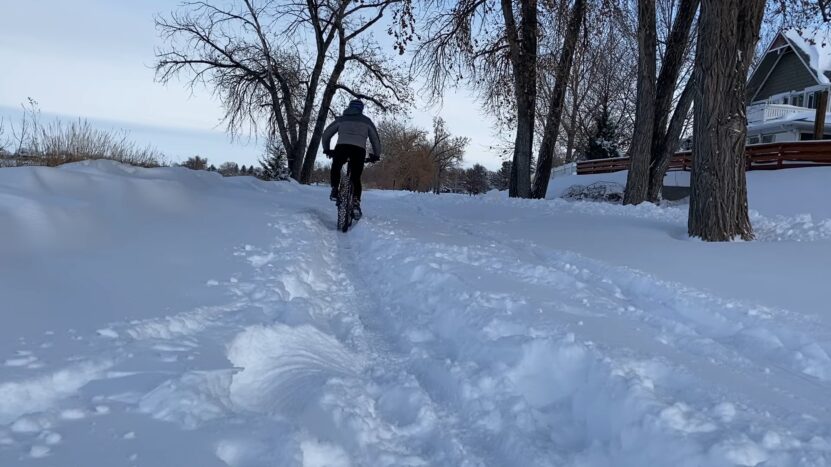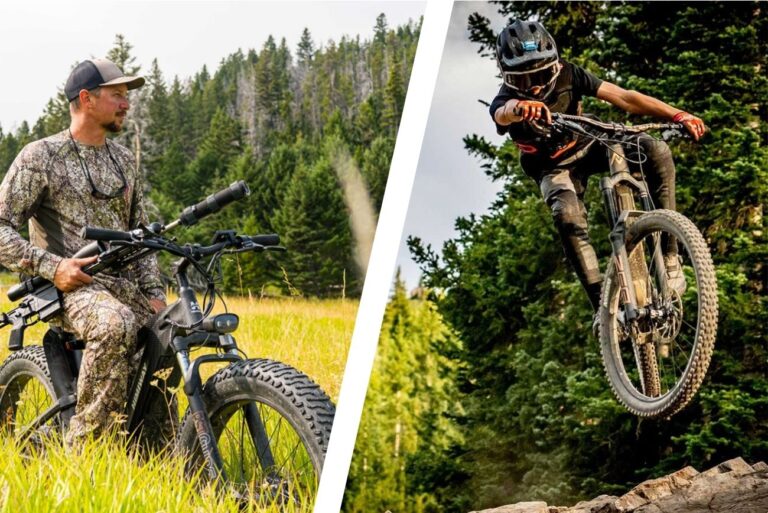Though both mountain bikes and fat bikes share some commonalities, there are also many important differences between the two types of bicycles. You might be wondering, then, which is the better option for you.
That decision will have a big impact on how your bike handles, what kind of terrain you can ride, and how much tire contact area you have with the ground. Here, we will pit fat bike vs mountain bike, so you can make an informed decision about which is the right kind of bike for you and your needs.
Fat Bike Vs Mountain Bike
The difference between the fat bike vs mountain bike is that the fat bike has wider tires while the mountain bike comes with standard-width tires. There are pros and cons to each, so it’s important to understand the difference before you make a decision.
Fat bikes have tires that are 3.7″ or wider. That might not sound like much, but it’s a big difference when you’re on the trail. The extra width gives you a lot more contact with the ground, which results in better traction and stability.
They also tend to be more forgiving than standard-width bikes, so they’re a good choice for riders who are just getting started. The downside of fat bikes is that they’re heavier and slower than standard-width bikes. The extra width also makes it more difficult to maneuver through tight spaces. If you’re looking for a bike that’s light and nimble, a fat bike might not be the best choice.
Mountain bikes with standard-width tires are a good all-around choice. They’re lighter and faster than fat bikes, so they’re easier to maneuver. And while they don’t have as much contact with the ground as fat bikes, they still have enough traction for most riding conditions.
If you’re not sure which type of bike is right for you, it’s a good idea to test-ride both. That way, you can get a feel for how each one handles and make an informed decision.
Fat Bike Overview
Fat bikes were first developed in the early 1990s for use in Alaska, where they were used for exploring off-road trails and hunting areas. In recent years, fat bikes have become popular in other snowy regions such as the U.S. Rocky
Mountains and Europe. Fat bikes are also gaining popularity in desert regions for their ability to ride over sand and other soft surfaces. There are a few different types of fat bikes, each designed for a specific type of riding. The most common type is the trail fat bike, which is designed for riding on trails and other off-road terrains.
Trail fat bikes typically have front and rear suspension, making them more comfortable to ride on rough terrain. Another type of fat bike is the race fat bike, which is designed for racing on hard-packed snow or dry dirt trails.
Race fat bikes typically have lighter frames and components than trail fat bikes, making them faster and more nimble. A fat bike is an off-road bicycle with oversized tires, typically 3.8 to 5 inches (97 to 127 mm) in width, and rims 2.6 to 4.0 inches (66 to 102 mm) in diameter.
Fat bikes are designed for low ground pressure to allow riding on soft, unstable terrain, such as snow or sand. The wide tires can also be used on all-terrain vehicle (ATV) trails. Fat bikes typically have very low gears to accommodate the extra weight of the bike and rider.
Fat bikes are available at a range of prices. Lower-end fat bikes may use steel frames and components, while higher-end models may use carbon fiber frames and components. Fat bikes are typically equipped with disc brakes, although some models may use rim brakes.
Fat bikes are a relatively new type of bicycle, so there is still a lot of research and development being done to improve their design and performance. Fat bikes are sure to become more popular in the coming years as more people discover the joy of riding on all types of terrain.
If you’re looking for a bike that can go anywhere and do anything, a fat bike is a perfect choice. Thanks to their oversized tires and low gears, fat bikes can tackle any type of terrain, making them the ultimate all-terrain vehicle. So whether you’re riding on sand, snow, or dirt, a fat bike can get you there.
Mountain Bike Overview
Mountain biking is a sport that has exploded in popularity in recent years. It’s a great way to get outdoors and explore nature, while also getting a workout. If you’re thinking about getting into it, there are a few things you should know.
First of all, mountain biking is not for the faint of heart. It can be a challenging sport, both mentally and physically. You need to be prepared for a workout, and you also need to be comfortable with riding in rougher terrain.
That being said, mountain biking can be an extremely rewarding experience. There’s nothing quite like the feeling of pedaling your way to the top of a difficult trail. And the sense of accomplishment you’ll feel when you reach the summit is unbeatable.
If you’re ready to take on the challenge of mountain biking, there are a few things you’ll need to get started. First, you’ll need a good mountain bike. There are many different types and styles of mountain bikes, so it’s important to do your research and find the one that’s right for you.
You’ll also need to invest in some basic mountain biking gear, like a helmet, gloves, and protective clothing. And finally, you’ll need to familiarize yourself with the basics of mountain bike riding before hitting the trails.
Fat Bike For Everyday Use
Here are some of the benefits of riding a fat bike:
- You’ll have more traction. Fat tires provide a better grip on all types of terrain, so you can feel confident taking on any terrain.
- You’ll be able to ride in all types of weather. Fat tires don’t mind getting wet, so you can keep riding no matter the conditions.
- You’ll have a smoother ride. Fat tires absorb bumps and vibrations, giving you a smoother ride on even the roughest roads.
So if you’re looking for a bike that can handle anything, a fat bike might be the perfect choice for you.
Full Suspension Mountain Bike Vs Fat Bike

Full-suspension mountain bikes are designed for riders who want a bike that can handle all types of terrain. These bikes have suspension forks and shocks at the front and rear of the bike, which helps to absorb bumps and protect the rider from being jarred around on rough terrain.
Full-suspension mountain bikes are typically heavier than other types of mountain bikes, but they offer a smoother ride. Fat bikes are a newer type of mountain bike that is becoming increasingly popular. Fat bikes have larger tires than other mountain bikes, which helps to provide traction on loose or icy surfaces.
Fat bikes also have a wider stance, which makes them more stable on uneven terrain. While fat bikes are not as lightweight as other mountain bike options, they can be a good choice for riders who want a bike that can handle all types of terrain.
Fat Bike Tires Vs Mountain Bike Tires
One of the biggest distinctions between fat bikes and mountain bikes is the width of the tires. Fat bike tires are typically much wider than mountain bike tires, which gives them more traction and stability on rough or soft terrain.
This can be a major advantage when riding in snow or sand, for example. However, wider tires also tend to be heavier and slower to accelerate, so they may not be ideal if you’re looking to go fast.
Mountain bike tires, on the other hand, are designed to be lightweight and fast-rolling. This makes them better suited for riding on hard-packed trails or dirt roads. They may not have as much traction as fat bike tires, but they can still handle most terrain reasonably well.
Are Fat Bikes Good For Long Distance

Fat bikes are becoming increasingly popular with long-distance riders, as they offer a number of advantages over traditional road bikes or mountain bikes.
First of all, fat bikes are extremely comfortable to ride. The wide tires provide a smooth ride, even over rough terrain. And because the tires are so large, they help to absorb vibrations and bumps, making for a much more pleasant riding experience.
Another advantage of fat bikes is that they’re very stable, thanks to their wide tires, it’s difficult to lose your balance or tip over. This is a big plus when you’re riding for long periods of time, as it means you can relax and enjoy the scenery without having to worry about crashing.
Finally, fat bikes are incredibly versatile. They can be ridden on almost any type of terrain, including sand, snow, and even ice. This makes them ideal for riders who want to explore new and interesting places, without being limited by the type of terrain they can ride on.
Fat Tire E-Bike Vs Mountain E-Bike
Fat tire e-bikes are designed for riding on rough terrains, such as sand or snow. They have wide tires that provide good traction and stability on uneven surfaces.
Mountain e-bikes, on the other hand, are designed for riding on more challenging terrain, such as steep hills and rocky trails. They have narrower tires and suspension systems that help absorb the shock of riding on rough terrain.
Both fat tire e-bikes and mountain e-bikes have their own unique benefits. Fat tire e-bikes are more versatile, as they can be ridden on a variety of different terrain types. Mountain e-bikes are more specialized and are therefore better suited for riding on more challenging terrain.
So, which type of e-bike is right for you? It really depends on what kind of riding you plan on doing.
Conclusion
So, which type of bike is right for you? If you’re looking for a bike that can handle all sorts of different terrain, a mountain bike is probably your best bet. But, if you’re planning on riding in snow or sand, or if you just want a bike that’s a little more stable, a fat bike might be the way to go.

